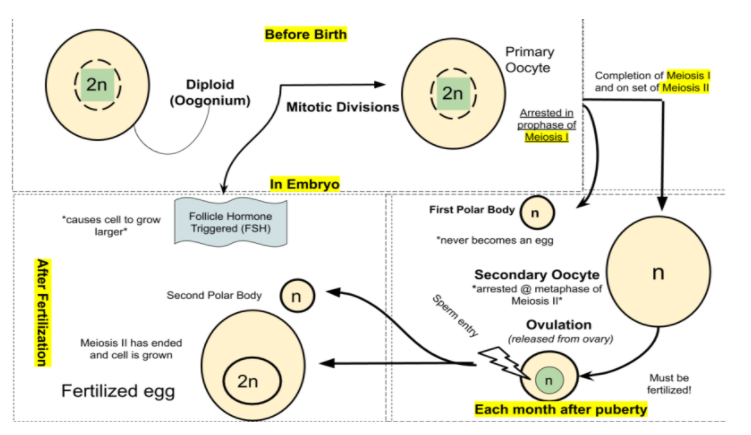
What is oogenesis? Explain with the help of a diagram.
Answer
554.1k+ views
Hint: Oogenesis is the process in which there is the formation and the development of an oocyte or ovum. It is the part of gametogenesis and the female gamete that is formed is called an ovum. This occurs in the primary sex organ ovary and is a discontinuous process.
Complete answer:

Gametogenesis- gametogenesis is defined as the process by which gametes are produced. It includes:
> Spermatogenesis
> Oogenesis
Oogenesis: oogenesis is the process in which there is the formation and the development of an oocyte or ovum. It is the part of gametogenesis and the female gamete that is formed is called an ovum. It occurs in the female ovary.
The ovary is called the sex organ in females in which the gamete (ovum) is formed. Formation of an ovum from a primordial germ cell is called oogenesis, it is a discontinuous process and includes the following steps:
> Multiplication phase- in this mitosis occurs and primordial germ cells develop into oogonia.
> Growth phase- in this oogonia develops into a primary oocyte.
> Maturation phase- meiosis occurs. Primary oocyte forms 1st polar body and secondary oocyte.
After sperm penetration, the secondary oocyte forms 2nd polar body and an ovum.
Throughout the whole process, the oocytes get surrounded by a layer of granulosa cells called the follicle. In the end, the tertiary follicle of the secondary oocyte gets converted to a graafian follicle which ruptures and releases a secondary oocyte called ovulation.
Secondary oocyte forms a haploid ovum and haploid second polar body.
Note:
The ovaries mature only one ovum within the follicle in a cycle of 28 days. It means a female can mature up to 13 eggs in one year. The structure of the ovum consists of primary, secondary, and tertiary membranes besides the plasma membrane.
Complete answer:

Gametogenesis- gametogenesis is defined as the process by which gametes are produced. It includes:
> Spermatogenesis
> Oogenesis
Oogenesis: oogenesis is the process in which there is the formation and the development of an oocyte or ovum. It is the part of gametogenesis and the female gamete that is formed is called an ovum. It occurs in the female ovary.
The ovary is called the sex organ in females in which the gamete (ovum) is formed. Formation of an ovum from a primordial germ cell is called oogenesis, it is a discontinuous process and includes the following steps:
> Multiplication phase- in this mitosis occurs and primordial germ cells develop into oogonia.
> Growth phase- in this oogonia develops into a primary oocyte.
> Maturation phase- meiosis occurs. Primary oocyte forms 1st polar body and secondary oocyte.
After sperm penetration, the secondary oocyte forms 2nd polar body and an ovum.
Throughout the whole process, the oocytes get surrounded by a layer of granulosa cells called the follicle. In the end, the tertiary follicle of the secondary oocyte gets converted to a graafian follicle which ruptures and releases a secondary oocyte called ovulation.
Secondary oocyte forms a haploid ovum and haploid second polar body.
Note:
The ovaries mature only one ovum within the follicle in a cycle of 28 days. It means a female can mature up to 13 eggs in one year. The structure of the ovum consists of primary, secondary, and tertiary membranes besides the plasma membrane.
Recently Updated Pages
Master Class 12 Business Studies: Engaging Questions & Answers for Success

Master Class 12 Economics: Engaging Questions & Answers for Success

Master Class 12 English: Engaging Questions & Answers for Success

Master Class 12 Maths: Engaging Questions & Answers for Success

Master Class 12 Social Science: Engaging Questions & Answers for Success

Master Class 12 Chemistry: Engaging Questions & Answers for Success

Trending doubts
What are the major means of transport Explain each class 12 social science CBSE

Which are the Top 10 Largest Countries of the World?

Draw a labelled sketch of the human eye class 12 physics CBSE

How much time does it take to bleed after eating p class 12 biology CBSE

Explain sex determination in humans with line diag class 12 biology CBSE

Differentiate between homogeneous and heterogeneous class 12 chemistry CBSE




